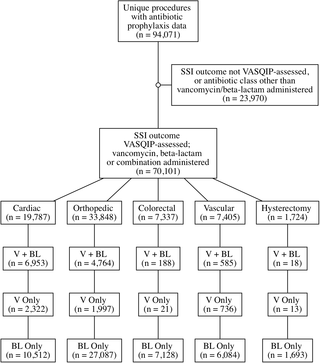PLOS Medicine ( IF 10.5 ) Pub Date : 2017-07-10 , DOI: 10.1371/journal.pmed.1002340 Westyn Branch-Elliman 1, 2, 3 , John E Ripollone 4 , William J O'Brien 3 , Kamal M F Itani 2, 5, 6 , Marin L Schweizer 7, 8 , Eli Perencevich 7, 8 , Judith Strymish 1, 2 , Kalpana Gupta 1, 3, 5

|
Background
The optimal regimen for perioperative antimicrobial prophylaxis is controversial. Use of combination prophylaxis with a beta-lactam plus vancomycin is increasing; however, the relative risks and benefits associated with this strategy are unknown. Thus, we sought to compare postoperative outcomes following administration of 2 antimicrobials versus a single agent for the prevention of surgical site infections (SSIs). Potential harms associated with combination regimens, including acute kidney injury (AKI) and Clostridium difficile infection (CDI), were also considered.
Methods and findings
Using a multicenter, national Veterans Affairs (VA) cohort, all patients who underwent cardiac, orthopedic joint replacement, vascular, colorectal, and hysterectomy procedures during the period from 1 October 2008 to 30 September 2013 and who received planned manual review of perioperative antimicrobial prophylaxis regimen and manual review for the 30-day incidence of SSI were included. Using a propensity-adjusted log-binomial regression model stratified by type of surgical procedure, the association between receipt of 2 antimicrobials (vancomycin plus a beta-lactam) versus either single agent alone (vancomycin or a beta-lactam) and SSI was evaluated. Measures of association were adjusted for age, diabetes, smoking, American Society of Anesthesiologists score, preoperative methicillin-resistant Staphylococcus aureus (MRSA) status, and receipt of mupirocin. The 7-day incidence of postoperative AKI and 90-day incidence of CDI were also measured. In all, 70,101 procedures (52,504 beta-lactam only, 5,089 vancomycin only, and 12,508 combination) with 2,466 (3.5%) SSIs from 109 medical centers were included. Among cardiac surgery patients, combination prophylaxis was associated with a lower incidence of SSI (66/6,953, 0.95%) than single-agent prophylaxis (190/12,834, 1.48%; crude risk ratio [RR] 0.64, 95% CI 0.49, 0.85; adjusted RR 0.61, 95% CI 0.46, 0.83). After adjusting for SSI risk, no association between receipt of combination prophylaxis and SSI was found for the other types of surgeries evaluated, including orthopedic joint replacement procedures. In MRSA-colonized patients undergoing cardiac surgery, SSI occurred in 8/346 (2.3%) patients who received combination prophylaxis versus 4/100 (4.0%) patients who received vancomycin alone (crude RR 0.58, 95% CI 0.18, 1.88). Among MRSA-negative and -unknown cardiac surgery patients, SSIs occurred in 58/6,607 (0.9%) patients receiving combination prophylaxis versus 146/10,215 (1.4%) patients who received a beta-lactam alone (crude RR 0.61, 95% CI 0.45, 0.83). Based on these associations, the number needed to treat to prevent 1 SSI in MRSA-colonized patients is estimated to be 53, compared to 176 in non-MRSA patients. CDI incidence was similar in both exposure groups. Across all types of surgical procedures, risk of AKI was increased in the combination antimicrobial prophylaxis group (2,971/12,508 [23.8%] receiving combination versus 1,058/5,089 [20.8%] receiving vancomycin alone versus 7,314/52,504 [13.9%] receiving beta-lactam alone). We found a significant association between absolute risk of AKI and receipt of combination regimens across all types of procedures. If the observed association is causal, the number needed to harm for severe AKI following cardiac surgery would be 167. The major limitation of our investigation is that it is an observational study in a predominantly male population, which may limit generalizability and lead to unmeasured confounding.
Conclusions
There are benefits but also unintended consequences of antimicrobial and infection prevention strategies aimed at “getting to zero” healthcare-associated infections. In our study, combination prophylaxis was associated with both benefits (reduction in SSIs following cardiac surgical procedures) and harms (increase in postoperative AKI). In cardiac surgery patients, the difference in risk–benefit profile by MRSA status suggests that MRSA-screening-directed prophylaxis may optimize benefits while minimizing harms in this selected population. More information about long-term outcomes and patient and societal preferences regarding risk of SSI versus risk of AKI is needed to improve clinical decision-making.
中文翻译:

使用万古霉素加β-内酰胺与单独使用任一药物进行抗生素预防后手术部位感染、急性肾损伤和艰难梭菌感染的风险:一项全国倾向评分调整回顾性队列研究
背景
围手术期抗菌药物预防的最佳方案存在争议。β-内酰胺加万古霉素联合预防的使用正在增加;然而,与该策略相关的相对风险和收益尚不清楚。因此,我们试图比较使用 2 种抗菌药物与单一药物预防手术部位感染 (SSI) 后的术后结果。还考虑了与联合治疗方案相关的潜在危害,包括急性肾损伤(AKI)和艰难梭菌感染(CDI)。
方法和结果
使用多中心、国家退伍军人事务部 (VA) 队列,研究了 2008 年 10 月 1 日至 2013 年 9 月 30 日期间接受心脏、骨科关节置换、血管、结直肠和子宫切除手术并接受围手术期抗菌预防计划人工审查的所有患者包括 SSI 30 天发生率的治疗方案和人工审核。使用按手术类型分层的倾向调整对数二项式回归模型,评估了接受 2 种抗菌药物(万古霉素加 β-内酰胺)与单独使用任一药物(万古霉素或 β-内酰胺)与 SSI 之间的关联。根据年龄、糖尿病、吸烟、美国麻醉医师协会评分、术前耐甲氧西林金黄色葡萄球菌(MRSA)状况以及莫匹罗星的接受情况调整关联测量。还测量了术后 7 天的 AKI 发生率和 90 天的 CDI 发生率。总共包括来自 109 个医疗中心的 70,101 例手术(52,504 例仅使用 β-内酰胺,5,089 例仅使用万古霉素,以及 12,508 例联合治疗),涉及 2,466 例 (3.5%) SSI。在心脏手术患者中,联合预防与单药预防(190/12,834,1.48%)相比,SSI 发生率较低(66/6,953,0.95%);粗风险比 [RR] 0.64,95% CI 0.49,0.85 ;调整后 RR 0.61,95% CI 0.46,0.83)。在调整 SSI 风险后,对于所评估的其他类型的手术(包括骨科关节置换手术),未发现接受联合预防与 SSI 之间存在关联。在接受心脏手术的 MRSA 定植患者中,接受联合预防的患者中有 8/346 (2.3%) 发生 SSI,而单独接受万古霉素的患者则有 4/100 (4.0%) 发生 SSI(粗 RR 0.58,95% CI 0.18,1.88)。在 MRSA 阴性和未知的心脏手术患者中,接受联合预防的患者中有 58/6,607 (0.9%) 例发生 SSI,而单独接受 β-内酰胺治疗的患者则有 146/10,215 (1.4%) 例发生 SSI(粗略 RR 0.61,95% CI 0.45) ,0.83)。根据这些关联,MRSA 定植患者中预防 1 SSI 所需治疗的人数估计为 53 人,而非 MRSA 患者则为 176 人。两个暴露组的 CDI 发生率相似。在所有类型的外科手术中,联合抗菌药物预防组发生 AKI 的风险增加(接受联合治疗的患者为 2,971/12,508 [23.8%],单独接受万古霉素治疗的患者为 1,058/5,089 [20.8%],而接受β-抗生素预防的患者为 7,314/52,504 [13.9%]。单独的内酰胺)。我们发现 AKI 的绝对风险与所有类型手术中接受联合治疗方案之间存在显着关联。如果观察到的关联是因果关系,则心脏手术后严重 AKI 造成伤害所需的人数将为 167。我们调查的主要限制是,这是一项以男性为主的人群中的观察性研究,这可能会限制普遍性并导致无法测量的混杂因素。
结论
旨在“实现零”医疗保健相关感染的抗菌和感染预防策略有好处,但也有意想不到的后果。在我们的研究中,联合预防与益处(减少心脏手术后的 SSI)和危害(增加术后 AKI)相关。在心脏手术患者中,MRSA 状态的风险效益差异表明,针对 MRSA 筛查的预防措施可能会在选定人群中优化获益,同时将危害降至最低。需要更多关于长期结果以及患者和社会对 SSI 风险与 AKI 风险的偏好的信息,以改善临床决策。











































 京公网安备 11010802027423号
京公网安备 11010802027423号